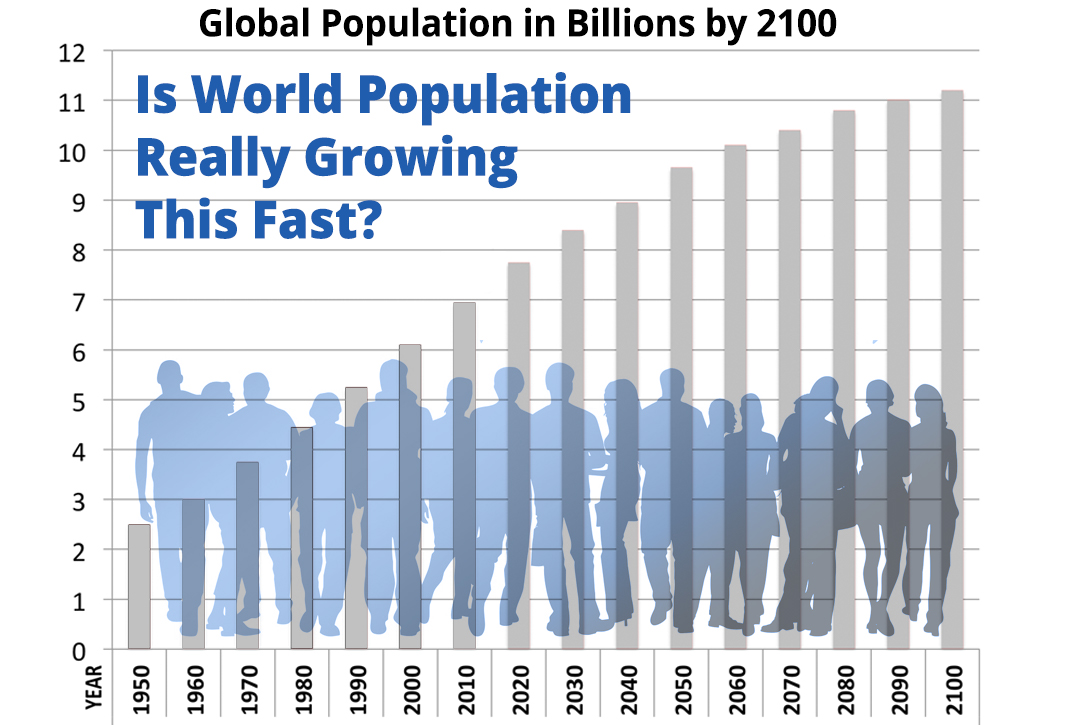Contrary to popular and long held assumptions, global population is declining. The environmental consequences are good, the economic consequences are bad, says this podcast guest.
Since the 1960s we’ve come to understand that an expanding global population threatens our quality of life — and, potentially, all life itself. Paul Ehrlich’s 1968 book, The Population Bomb, set the stage for 50 years of doom-laden assumptions about population growth.
But our guest on this week’s WhoWhatWhy podcast, Canadian journalist John Ibbitson, offers a new and surely controversial perspective. He contends that population estimates are way off, and that if the errors continue, by the end of the 21st century the official figures may be overstated by as many as two billion people.
Ibbitson — the co-author (with Darrell Bricker) of Empty Planet: The Shock of Global Population Decline — points out that for much of history, population was kept down by catastrophe, famine, or disease. Now, he says, human population is still facing suppression, but the mechanisms are more subtle and not well understood. He contends that mass migrations to cities, the empowerment of women, and a decline of religion’s influence have all impacted population in a way that has eluded demographers.

For example: The population of Japan’s wildly overcrowded string of islands shrank by 450,000 in the past year alone; China, famed for pushing fertility, is now below replacement rate, and even in historically bursting India the population appears to be no longer rising.
All this, combined with longevity increasing just as fertility rates are dropping, will have severely negative economic consequences.
Indeed, Ibbitson argues that given the actual population figures, more cross-border immigration will be needed to staff tomorrow’s workforce. Even East Asia, he says, will have to forgo its traditional homogeneity if it is to prosper economically.
Ibbitson further shows that this is not just a trend or a cycle: History has no examples where the acceptance of smaller families has been reversed.
The prospect of two billion fewer people on the planet by century’s end should relieve fears of food shortages, conflicts over arable land, and further environmental degradation. But unless politicians and the media acknowledge the economic challenges of an impending decline in world population, the transition will be costly and painful.
Click HERE to Download Mp3
Related front page panorama photo credit: Adapted by WhoWhatWhy from Jazmin Million / Flickr (CC BY-SA 2.0).
Full Text Transcript:
As a service to our readers, we provide transcripts with our podcasts. We try to ensure that these transcripts do not include errors. However, due to time constraints, we are not always able to proofread them as closely as we would like. Should you spot any errors, we’d be grateful if you would notify us.
| Jeff Schechtman: | Hello, welcome to Radio WhoWhatWhy. I’m Jeff Schechtman. |
| It’s always surprising how much conventional wisdom and scientific assumptions are often wrong. One such bit of wisdom is that the world’s population will quickly overtake our ability to handle it. This has been drilled into our collective consciousness, certainly since Paul Ehrlichman’s bombshell book, The Population Bomb, in 1968. Over the decades the population explosion has been the stuff of both public policy planning and science fiction. After all, who could forget Soylent Green. | |
| But think how different the world was in 1968. Since then, the onslaught of technology, the great migration to our cities, and the rise in the social status, education and contribution of women are all things that demographers arguably missed. So that today, as the populations of advanced industrial nations age, as we are seeing in Japan, Europe, China, and the US, and the population is not even replacing itself, we face a population in economic crisis of a completely different kind. And now that problem might even get worse. Remember AOC’s comments about people thinking twice about bringing kids into a world with the threat of climate change. | |
| We’re going to talk about this crisis of declining population today with my guest, John Ibbitson. John Ibbitson is a writer-at-large for Canada’s Globe and Mail. He’s the co-author of one of the most important books about Canadian politics entitled The Big Shift. And it is my pleasure to welcome John Ibbitson here to talk about Empty Planet, The Shock of the Global Population Decline. | |
| John Ibbitson, welcome to Radio WhoWhatWhy. | |
| John Ibbitson: | Hello Jeff. |
| Jeff Schechtman: | Well, it’s great to have you here. Why have demographers in the media consistently gotten this so wrong? |
| John Ibbitson: | The United Nations Population Division has a really good track record at predicting population growth. They’ve been doing it since the 1950s and they’ve been doing it well. They predicted that by around now we would be at seven and a half billion people or so, and we are at about seven and a half billion people or so. And they predict that, by the end of this century, we will have gone past 11 billion. There’s every reason to believe that since the United Nations Population Division got it right in the past that they’re going to get it right in the future as well. That’s a reasonable assumption. |
| However, that assumption is flawed. There is another group of demographers who say that United Nations assumptions are wrong. That the population is not going to get to 11 billion, it’s only going to get to 9 billion, sometime around the middle of the century. And then it’s going to start going down and going down quite quickly. | |
| Darrell Bricker, my co-author, and I believe that these dissident demographers are right, that the evidence on the ground suggests that the UN assumptions are out of date and that they should change those assumptions. And if they do, the UN too will start to adjust its numbers to around 9 billion rather than 11 billion. | |
| Jeff Schechtman: | What are some of those assumptions that are fundamentally wrong? One certainly, and you talk a lot about this, is the shifting of the population from rural to urban, that that’s really one of the key indicators here. |
| John Ibbitson: | It is absolutely the key indicator. The United Nations fails to understand the pace of urbanization. We are now a mostly urban species. About 55% of humanity lives in cities. |
| We’ve already seen this happening of course in the developed world, but it is happening at a tremendous clip in the developing world now as well. When people move from countryside to city side, four things happen. First off a kid stops being an economic asset, another pair of hands to work in the field and becomes a liability, just another mouth to feed. | |
| The second thing that happens, and this is perhaps the most important of all, women, when they move from the countryside to the city have access to information they didn’t have before. They have education. They have schools. They have media. They have other women who are able to educate each other. As women become better educated, invariably, they begin to demand more autonomy over their lives. As they have obtained more autonomy over their lives, one of their first decisions is to have fewer children than their mother had. | |
| The second … the third influence is one of religion, which is more powerful in the countryside than it is in the city. As the power of religion weakens, the ability of the priest, or whoever, to tell you that you must get married and settle down and have many kids weakens. | |
| And finally, the power of the clan weakens. You have fewer authorities telling you that it’s time for you to get married and settle down and have kids. And your biggest influences, your coworkers and your friends, who rarely are urging you to have another baby. | |
| So economics, the education of women, the declining power of religion, the declining part of the clan, these all conspire to push down fertility rates once people move from the countryside to the city. | |
| Jeff Schechtman: | There is this assumption that has been prevailing for a long time that somehow population decline, and drops in fertility rates, and drops in population replacement, was somehow a negative social indicator. That’s not necessarily true. |
| John Ibbitson: | No, absolutely not. A declining birth rate is everywhere in the world, correlative with the increasing education and empowerment of women. Again, the declining fertility rates that we’re seeing in the developing world go along with women in the developing world having more control over their lives than they had in the past. |
| So yes, as women obtain better education and more autonomy, more ability to decide for themselves what they want to do with their lives, fertility rates drop. In that sense, population decline is entirely a good thing. | |
| Jeff Schechtman: | To what extent are economics and globalization a significant part of what we’re seeing here? |
| John Ibbitson: | The globalization is helping to improve living standards in the developing world, and as living standards improve education improves, fertility rates go down. |
| We all know that the developed world has been below replacement rate for many years. We have about two dozen countries around the world that are losing population every year right now because they don’t have the 2.1 fertility rate that’s required to keep us at population stable. | |
| It’s no surprise that Japan, for example, lost almost 450,000 people last year. That populations are declining in Eastern Europe and in other parts of the developed nations in Eastern Asia as well. But, China is going to start losing population in the next decade. It’s the world’s most populous country. It’s below replacement rate. It will start losing population in the next decade. India has reached replacement rate. You can no longer look to India as this great source of population growth because they are now at 2.1. Brazil, the world’s fifth largest country. They’re at 1.8. They are well below replacement rate and they are going to start losing population as well. | |
| As you look around the world, where are the big centers of population growth? Where are the big places where lots and lots of babies are going to be born? Apart from Sub-Saharan Africa, we are running out of places to produce those babies. | |
| Jeff Schechtman: | And as the population, the aging population, lives longer and the replacement rate continues to drop, talk about the economic implications of that. |
| John Ibbitson: | They are challenging. Yes, our thesis would be even more evident if longevity weren’t increasing in the very same places where fertility rates are dropping. But they are. People are living longer everywhere in the world, including in the developing world. But there are two consequences to that. |
| First of all, when you have fewer young people every year that you had the year before, which is the inevitable result of below replacement fertility rates, then you have fewer young people who are able to pay the taxes needed to sustain all the old people who require healthcare and pensions. | |
| The other impact is on consumption. Economies are driven by consumption. That is the single most important factor in economic growth. Consumption is driven by young people. People who have graduated from school and are buying the first house or the first car. Having their first kid. The stroller that’s needed for the kid. The minivan that replaces the car for the kid. | |
| All of these things that the 20 somethings, and 30 somethings, and 40 somethings, even 50 somethings, acquire over the course of the decade. That drives economic growth. But when there were fewer of those people around, then there are fewer people to drive and to consume. Fewer people to drive growth. And it makes it harder for a society to continue to finance the things that it needs to finance to sustain the lifestyle that people are accustomed to. | |
| Jeff Schechtman: | As we look at population historically, is this something that is cyclical or is this something that is more systemic right now? |
| John Ibbitson: | Absolutely systemic. If you look at a 1800. An American woman around … a white woman, and unfortunately there’s no data for Native Americans or African Americans, but a white woman in 1800 would have seven babies. A white woman in 1900 would have four. The United States halved its fertility rate in over the course of the 19th century. Then it went down and down and down and then the blip of the baby boom for a couple of decades made it look as though things were changing. But it was just a blip and then it went back to going down and down and down again. It’s, in fact, the latest data shows that the fertility rate in United States is at the lowest level it has ever been. |
| John Ibbitson: | It took the United States more than a century and a half to get its fertility rate down below replacement rate. But this is happening in a generation, in most parts of the developing world. It only goes in one direction, and it’s accelerating. |
| Jeff Schechtman: | To the extent that it’s accelerating, talk a little bit about how low it can go. What is the potential right now, given the other social and economic factors that we see? |
| John Ibbitson: | It’s a good question and it may differ from culture to culture. It may be that the United States, for example, levels out at around 1.5, 1.6, 1.7 and stays there. Canada has had a fertility rate of around 1.5-1.6 now, for several decades. But on the other hand, in Eastern Asia, the fertility rate is dropping below one in many places. It’s dropped down to one in South Korea for example. That’s half of a … that’s a whole baby less than they need to sustain their populations. |
| If it keeps going down to that level, then you could see re-precipitous declines in population, again, in some of the biggest countries in the world. If China’s population fertility rate begins to mirror the fertility rate in Japan and South Korea and the other countries on its borders, then we could see China lose, not 300 million people this century, which is what they project, but up to 600 million people this century. Imagine what would happen to the world that we live in if China goes from having 1.3 billion people to only 600 or 700 million. | |
| Jeff Schechtman: | Of course, the other part of this is that when you look at this decline in places like China and Japan, for example, which are very homogeneous with respect to their population, and have not done a lot with respect to immigration, there’s real impact on the labor force in those countries. |
| John Ibbitson: | A real impact on the labor force, and a huge impact on geopolitics. You’re absolutely right. |
| Eastern Asia does not welcome immigration. The Japanese do not make it very easy for you to obtain Japanese citizenship. China does not welcome immigrants. The United States here has a tremendous advantage, as well as my country of Canada has a tremendous advantage because we are immigrant nations. We are set for cultures. | |
| If the United States does not close the door to immigrants, and I know this is a huge debate in United States, but if you do not close the door to immigration, if you keep taking in about a million people a year, as you’re doing right now, the gap in population between the United States and other places, such as China, is going to narrow. This will be a huge geopolitical advantage for the US going forward. It will also allow the US, again, to sustain its economy and its labor force in a way that other countries are unable to. | |
| Jeff Schechtman: | And it opens the door for huge debates about immigration in some of these Asian nations that we were talking about before. |
| John Ibbitson: | Yes. The cultural imperatives of homogeneity in Eastern Europe is powerful, but the Japanese are now, for the first time, really grappling with this issue. How do they keep their populations from dropping below 100 million people? Which is what they are at risk of doing over the course of the coming decades. They’re talking about bringing in a great many temporary laborers to at least look after the issue of job shortages. But that’s not a long term solution. But we see the same thing happening in Eastern Europe. There are countries in Eastern Europe that are losing population, but are also closing their door to immigration. They would rather decline then prosper. |
| Jeff Schechtman: | What are some nations doing, and China seems to be at least looking at some of these things, to encourage increase in population, encourage the birth rate? |
| John Ibbitson: | The Scandinavian countries have been at this now for decades. In fact, the social safety net that is thought of as the Scandinavian model was initially put in place to encourage Scandinavian women to have more babies because they were the first to really get at how serious a problem this could become for their economies. |
| What the Scandinavian model teaches us is, if you spend a great deal of money to encourage people to have kids. If you have a year and a half fully paid family leave. If you have heavily subsidized daycare. If you have direct payments to parents for having children, you can increase the fertility rate of your society a bit. But you can’t increase it by much. You can maybe get it up to from 1.5 to 1.7 or 1.8, but you cannot get it up to 2.1. At least the Scandinavian countries have not succeeded in getting it up to 2.1. And it is incredibly expensive, and when the next recession comes along, there’s tremendous pressure to cut back on those programs, which is something we’ve also seen. | |
| One of the reasons for this, in fact, the most important reason for this is something called the low fertility trap. You, Jeff, know exactly what the low fertility trap is, even though you’ve never heard of it. When you get used to having only one or two kids, as the norm in a society, you get used to having only one or two kids as the norm in the society. | |
| Jeff Schechtman: | Right. |
| John Ibbitson: | You live in a world where your friends, people you know, your family members, everyone around you, your coworkers, they have one or two kids. If you knew a friend who said, we decided to have six children, you would go, that’s odd. Why are you having six children? |
| It just becomes the norm. It becomes expected. And having a child is something that you have for different reasons then you had in the past. You don’t have it because God tells you you must. You don’t have it because the state is encouraging you to. You don’t have it because clan members are urging you to settle down. You have it because you and your partner want to have a child as an expression of the fulfillment of your own lives. | |
| As people discovered that having children is something they want to do in order to express and fulfill their lives, they find out that one or two kids is all they need to be completely fulfilled. Some people just get a dog instead. | |
| Jeff Schechtman: | Right. |
| John Ibbitson: | Once you’re in that world, you’re in that world. We don’t have any examples anywhere in the world where people flip back to saying, no, we want to live in a society where three is the norm. The women in those societies just say, no, we don’t. I don’t want to have a kid until I’m 29 or 30. That means I can only have one or two. Career matters more. Disposable income matters more. Just other things in my life matter more, and my partner agrees with this and that’s how we’re going to live our lives. Not much the government could do about that. |
| Jeff Schechtman: | Right. All of those things though are social constructs and, arguably, certainly could be subject to being of a cyclical nature. Even population shifting is potentially cyclical. People may get tired of urbanization at a certain point and move towards more rural places. That certainly, potentially, could drive population increase in the future. |
| John Ibbitson: | Well, sure. But it’s way beyond the scope of our book. |
| Jeff Schechtman: | Right. |
| John Ibbitson: | I think it is reasonable to say that the patterns that have been in place, since the industrial revolution, and that are still playing out in the developed world and now increasingly in the developing world, will continue to play out for another generation or two. Which is another … let us say, 50 to 75 years. Well let’s just say to the end of the century. |
| What will happen in the next century? Will there be a desire for people to migrate to the countryside? Will there be … will people just get lonely? Will they have been … I wish I wasn’t just an only child, let’s you and I make sure that our kids have lots of brothers and sisters. That could happen. Who knows? | |
| What we know right now though is that migration patterns are beginning to slow down. They’re rather disguised by the crises that we’re having in the Middle East. But, as India moves to a replacement rate, as China is well below replacement rate, as the Philippines moves towards replacement rate, the sources of immigrants is going to go down. The Philippines, China and India are Canada’s three major source countries. Your major source countries are all south of the border. Almost all the countries now in Latin America are at or below replacement rate. So the supply of Latino immigrants is going to start to diminish over time for that reason as well. | |
| Jeff Schechtman: | Is there any reason to think that climate change, the impacts of climate change, will have any effect on this? |
| John Ibbitson: | No. This will have an impact on climate change. The opposite is true. This is the really good news. |
| We say in the book, population decline isn’t good news or bad news, it’s just big news. We’ve talked about the geopolitical consequences. We’ve talked about the economic consequences. On the environmental side, it’s all great. | |
| If we peak out at 9 billion, at the middle of the century, that will help in our efforts to reduce global warming, to reduce carbon emissions. Both because there will be fewer of us on the planet to produce emissions and also because, and you’ve seen this happen in the United States, I’ve seen this happen in Canada, a lot of marginal farmland goes back to bush as people urbanize. When that happens the newly created bush acts as a carbon sink and also increases biodiversity. In terms of biodiversity, in terms of food chain, in terms of renewing the oceans, everything is good about population decline on the environmental side. | |
| Jeff Schechtman: | Why do you think more people are not talking about this? |
| John Ibbitson: | Well, we argue in the book that population decline is something that’s happening here and now. It’s happening in the decisions that you are making and that your readers and listeners are making. But it is also, on the other hand, kind of hard to get people to look at the impacts of that 40 or 50 years down the road. We’re having a hard time getting people to understand the impacts of climate change. Even though those impacts are starting to show up in weather systems right here, right now. |
| And there is such an entrenched conventional wisdom of nothing but population growth. Thanos is right, we have to wipe out half the population of the galaxy. | |
| All of those things are just so entrenched that even though a group of demographers have pretty good evidence, and Darrell and I travel to six continents talking to people. Not just experts, but we went into slums in Delhi, and university campuses in Seoul to talk to young women in every possible environment. Even though there is this growing body of evidence that in fact population growth isn’t going to go where a lot of people say it’s going to go, you just have the dead weight of collective assumptions, conventional wisdom. And it takes a while to shift that. | |
| Jeff Schechtman: | John Ibbitson, Empty planet, The Shock of Global Population Decline. John, I thank you so much for spending time with us today. |
| John Ibbitson: | Been my pleasure. |
| Jeff Schechtman: | Thank you. |
| And thank you for listening and for joining us here on Radio WhoWhatWhy. I hope you join us next week for another Radio WhoWhatWhy Podcast. I’m Jeff Schechtman. | |
| If you liked this podcast, please feel free to share and help others find it by rating and reviewing it on iTunes. You can also support this podcast and all the work we do by going to whowhatwhy.org/donate. |






